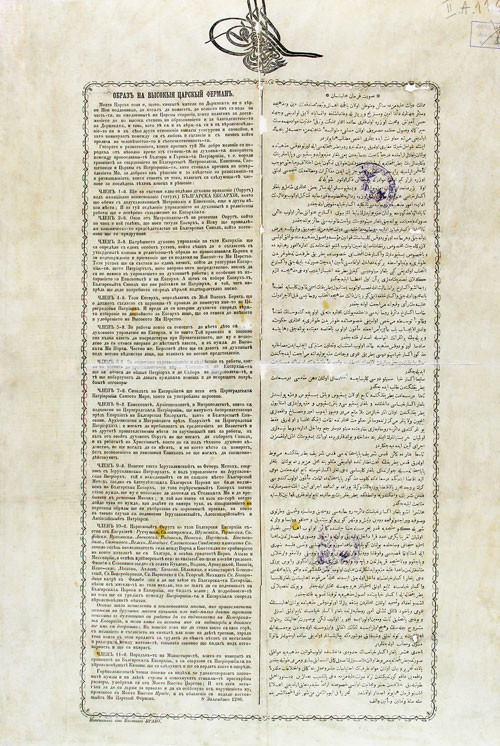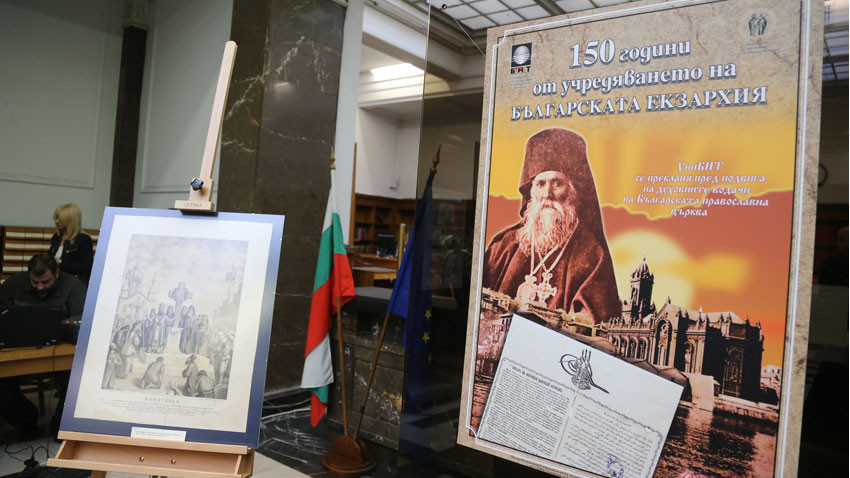On February 28, 1870, the Grand Vizier of the Ottoman Empire Ali Pasha recognized the right of Bulgarians to have an independent church separate from the Patriarchate of Constantinople. After a decade of struggles for Bulgarian ecclesiastical independence, Sultan Abdulaziz issued a ferman (a decree) establishing an independent Bulgarian Exarchate within the Patriarchate of Constantinople. The document, embodying the hopes of the Bulgarian Orthodox clergy and believers, was shown to the Bulgarian community in the imperial capital on March 1 from the pulpit of the church of St. Stephen.
 “The decree is connected with the establishment of the first officially recognized Bulgarian institution after nearly 500 years of no Bulgarian statehood and many years of national struggle,” head of the National Library Assoc. Prof. Krassimira Alexandrova told the Bulgarian National Radio. The sultan’s ferman and the Exarchate’s rules established at the national council convened in Constantinople in the following 1871, led to the official recognition of the Bulgarian Exarchate as the representative of the Bulgarian people in the Ottoman Empire."
“The decree is connected with the establishment of the first officially recognized Bulgarian institution after nearly 500 years of no Bulgarian statehood and many years of national struggle,” head of the National Library Assoc. Prof. Krassimira Alexandrova told the Bulgarian National Radio. The sultan’s ferman and the Exarchate’s rules established at the national council convened in Constantinople in the following 1871, led to the official recognition of the Bulgarian Exarchate as the representative of the Bulgarian people in the Ottoman Empire."
The sultan’s ferman written in two languages has an important place among the original documents presented at the National Library "St. Cyril and Methodius in Sofia” on the occasion of the 150th anniversary since founding of the Bulgarian Exarchate.
Among the rich exhibits from the library's collection, the exhibition also features another unique document – the Sultan’s berat (type of official document), related to the appointment of Exarch Antim I.
"The document bears the date April 12, 1872. It impresses with its exquisite calligraphy and size – 1.50 meters by 75 centimeters.

It is extremely well preserved to this day,” says Assoc. Prof. Alexandrova, adding: “The difference between the ferman and the berate is that the ferman determines the creation of the Exarchate, and the berate - the appointment of the first Exarch.
It is our duty to awaken the memories of those great Bulgarian figures who managed with patriotism, courage, and their own personal means to create the Exarchate. At the National Library, we jealously guard these documents and strive to make them available to the public on various occasions. The more purposefully we do so, the more we might expect results related to national self-esteem, national pride, and knowledge of our history."
The exhibition also includes a map of Bulgaria, outlining the borders of the Bulgarian regions, approved by the Sultan's ferman from February 19, 1870.

The exhibition, dedicated to the anniversary of the founding of the Bulgarian Exarchate, can be seen until mid-March.
Editor: Elena Karkalanova /based on Interview with BNR Horizon Program/
English: Alexander Markov
Photos: BGNES, BTA and archiveThe book "Icons from the National Church Historical and Archaeological Museum" - a huge work of over 500 pages, with more than 700 published photographs and accompanying scientific articles, was officially presented a few days ago. The unique..
A humble military chaplain made his first contact with Bulgaria in 1921, arriving with the mission of searching for Italian soldiers who had disappeared without a trace during World War I. However, he did not remain indifferent to the fate of this small..
Beloslav is a small town on one of the branches of Varna Lake. Yet it is here, in this quiet little town, that the only preserved Bulgarian submarine – Slava – is anchored . It was decommissioned a long time ago, and has now been turned in one of..

+359 2 9336 661
